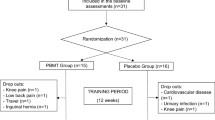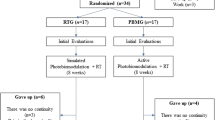Abstract
Aging is responsible by a series of morphological and functional modifications that lead to a decline of muscle function, particularly in females. Muscle tissue in elderly people is more susceptible to fatigue and, consequently, to an increased inability to maintain strength and motor control. In this context, therapeutic approaches able of attenuating muscle fatigue have been investigated. Among these, the photobiomodulation demonstrate positive results to interacts with biological tissues, promoting the increase in cell energy production. Thus, the aim of this study was to investigate the effects of photobiomodulation (808 nm, 250 J/cm2, 100 mW, 7 J each point) in the fatigue level and muscle performance in elderly women. Thirty subjects entered a crossover randomized double-blinded placebo-controlled trial. Photobiomodulation was delivered on the rectus femoris muscle of the dominant limb immediately before the fatigue protocol. In both sessions, peripheral muscle fatigue was analyzed by surface electromyography (EMG) and blood lactate analysis. Muscle performance was evaluated using an isokinetic dynamometer. The results showed that photobiomodulation was able of reducing muscle fatigue by a significant increase of electromyographic fatigue index (EFI) (p = 0.047) and decreasing significantly lactate concentration 6 min after the performance of the fatigue protocol (p = 0. 0006) compared the placebo laser session. However, the photobiomodulation was not able of increasing muscle performance measured by the isokinetic dynamometer. Thus, it can be conclude that the photobiomodulation was effective in reducing fatigue levels. However, no effects of photobiomodulation on muscle performance was observed.


Similar content being viewed by others
References
Clark BC, Manini TM (2010) Functional consequences of sarcopenia and dynapenia in the elderly. Curr Opin Clin Nutr Metab Care 13(3):271–276. doi:10.1097/MCO.0b013e328337819e
Barton M (2014) Aging and endothelin: determinants of disease. Life Sci 118(2):97–109. doi:10.1016/j.lfs.2014.09.009
Gault ML, Willems ME (2013) Aging, functional capacity and eccentric exercise training. Aging Dis 4(6):351–363. doi:10.14336/AD.2013.0400351
Frontera WR, Hughes VA, Fielding RA, Fiatarone MA, Evans WJ, Roubenoff R (2000) Aging of skeletal muscle: a 12-yr longitudinal study. J Appl Physiol 88:1321–1326
Thompson LV (2002) Skeletal muscle adaptations with age, inactivity, and therapeutic exercise. J Orthop Sports Phys Ther 32(2):44–57
Manini TM, Clark BC (2012) Dynapenia and aging: an update. J Gerontol A Biol Sci Med Sci 67(1):28–40. doi:10.1093/gerona/glr010
Arazi H, Damirchi A, Asadi A (2013) Age-related hormonal adaptations, muscle circumference and strength development with 8 weeks moderate intensity resistance training. Ann Endocrinol (Paris) 74(1):30–35. doi:10.1016/j.ando.2012.11.004
Vandervoort AA (2002) Aging of the human neuromuscular system. Muscle Nerve 25(1):17–25
de Rekeneire N, Leo-Summers L, Han L, Gill TM (2014) Epidemiology of restricting fatigue in older adults: the precipitating events project. J Am Geriatr Soc 62(3):476–481. doi:10.1111/jgs.12685
Kent-Braun JA (2009) Skeletal muscle fatigue in old age: whose advantage? Exerc Sport Sci Rev 37(1):3–9. doi:10.1097/JES.0b013e318190ea2e
Pasquet B, Carpentier A, Duchateau J, Hainaut K (2000) Muscle fatigue during concentric and eccentric contractions. Muscle Nerve 23:1727–1735
Rahnama N, Lees A, Reilly T (2006) Electromyography of selected lower-limb muscles fatigued by exercise at the intensity of soccer match-play. J Electromyogr Kinesiol 16:257–263
Barnet A (2006) Using recovery modalities between training sessions in elite athletes: does it help? Sports Med 36:781–796
Ferraresi C, Hamblin MR, Parizotto NA (2012) Low-level laser (light) therapy (LLLT) on muscle tissue: performance, fatigue and repair benefited by the power of light. Photonics Lasers Med 1(4):267–286
Leal Junior EC, Lopes-Martins RA, Vanin AA, Baroni BM, Grosselli D, De Marchi T, Iversen VV, Bjordal JM (2009) Effect of 830 nm low-level laser therapy in exercise-induced skeletal muscle fatigue in humans. Lasers Med Sci 24(3):425–431. doi:10.1007/s10103-008-0592-9
Toma RL, Tucci HT, Antunes HK, Pedroni CR, de Oliveira AS, Buck I, Ferreira PD, Vassão PG, Renno AC (2013) Effect of 808 nm low-level laser therapy in exercise-induced skeletal muscle fatigue in elderly women. Lasers Med Sci 28(5):1375–1382. doi:10.1007/s10103-012-1246-5
Karu TI, Kolyakov SF (2005) Exact action spectra for cellular responses relevant to phototherapy. Photomed Laser Surg 23(4):355–361
Karu TI (2010) Multiple roles of cytochrome c oxidase in mammalian cells under action of red and IR-A radiation. IUBMB Life 62(8):607–610. doi:10.1002/iub.359
Ferraresi C, Parizotto NA, Pires de Sousa MV, Kaippert B, Huang YY, Koiso T, Bagnato VS, Hamblin MR (2014) Light-emitting diode therapy in exercise-trained mice increases muscle performance, cytochrome c oxidase activity, ATP and cell proliferation. J Biophotonics 6:9999. doi:10.1002/jbio.201400087
Albuquerque-Pontes GM, Vieira Rde P, Tomazoni SS, Caires CO, Nemeth V, Vanin AA, Santos LA, Pinto HD, Marcos RL, Bjordal JM, de Carvalho PT, Leal-Junior EC (2015) Effect of pre-irradiation with different doses, wavelengths, and application intervals of low-level laser therapy on cytochrome c oxidase activity in intact skeletal muscle of rats. Lasers Med Sci 30(1):59–66. doi:10.1007/s10103-014-1616-2
Ferraresi C, de Sousa MV, Huang YY, Bagnato VS, Parizotto NA, Hamblin MR (2015) Time response of increases in ATP and muscle resistance to fatigue after low-level laser (light) therapy (LLLT) in mice. Lasers Med Sci 30(4):1259–1267. doi:10.1007/s10103-015-1723-8
Bakeeva LE, Manteĭfel’ VM, Rodichev EB, Karu TI (1993) Formation of gigantic mitochondria in human blood lymphocytes under the effect of an He-Ne laser. Mol Biol (Mosk) 27(3):608–617, Russian
De Marchi T, Leal Junior EC, Bortoli C, Tomazoni SS, Lopes-Martins RA, Salvador M (2012) Low-level laser therapy (LLLT) in human progressive-intensity running: effects on exercise performance, skeletal muscle status, and oxidative stress. Lasers Med Sci 27(1):231–236. doi:10.1007/s10103-011-0955-5
Vieira WH, Ferraresi C, Perez SE, Baldissera V, Parizotto NA (2012) Effects of low-level laser therapy (808 nm) on isokinetic muscle performance of young women submitted to endurance training: a randomized controlled clinical trial. Lasers Med Sci 27(2):497–504. doi:10.1007/s10103-011-0984-0
Dos Reis FA, da Silva BA, Laraia EM, de Melo RM, Silva PH, Leal-Junior EC, de Carvalho PT (2014) Effects of pre- or post-exercise low-level laser therapy (830 nm) on skeletal muscle fatigue and biochemical markers of recovery in humans: double-blind placebo-controlled trial. Photomed Laser Surg 32(2):106–112. doi:10.1089/pho.2013.3617
Leal Junior EC, Lopes-Martins RA, de Almeida P, Ramos L, Iversen VV, Bjordal JM (2010) Effect of low-level laser therapy (GaAs 904 nm) in skeletal muscle fatigue and biochemical markers of muscle damage in rats. Eur J Appl Physiol 108(6):1083–1088. doi:10.1007/s00421-009-1321-117
Ruiter CJ, Korte A, Schreven S, Haan A (2010) Leg dominancy in relation to fast isometric torque production and squat jump height. Eur J Appl Physiol 108:247–255
Higashi RH, Toma RL, Tucci HT, Pedroni CR, Ferreira PD, Baldini G, Aveiro MC, Borghi-Silva A, de Oliveira AS, Renno AC (2013) Effects of low-level laser therapy on biceps braquialis muscle fatigue in young women. Photomed Laser Surg 31(12):586–594. doi:10.1089/pho.2012.3388
Hermens HJ, Freriks B, Disselhorst-Klug C, Rau G (2000) Development of recommendations for SEMG sensors and sensor placement procedures. J Electromyogr Kinesiol 10(5):361–374
R Development Core Team (2008) R: a language and environment for statistical computing. R Foundation for Statistical Computing, Vienna, ISBN 3-900051-07-0, URL http://www.R-project.org
dos Santos Maciel T, Muñoz IS, Nicolau RA, Nogueira DV, Hauck LA, Osório RA, de Paula Júnior AR (2014) Phototherapy effect on the muscular activity of regular physical activity practitioners. Lasers Med Sci 29(3):1145–1152. doi:10.1007/s10103-013-1481-4
Baroni BM, Leal Junior EC, De Marchi T, Lopes AL, Salvador M, Vaz MA (2010) Low level laser therapy before eccentric exercise reduces muscle damage markers in humans. Eur J Appl Physiol 110(4):789–796. doi:10.1007/s00421-010-1562-z
Karu TI, Pyatibrat LV, Afanasyeva NI (2005) Cellular effects of low power laser therapy can be mediated by nitric oxide. Lasers Surg Med 36(4):307–314
Paolillo FR, Corazza AV, Borghi-Silva A, Parizotto NA, Kurachi C, Bagnato VS (2013) Infrared LED irradiation applied during high-intensity treadmill training improves maximal exercise tolerance in postmenopausal women: a 6-month longitudinal study. Lasers Med Sci 28(2):415–422. doi:10.1007/s10103-012-1062-y
Place N, Yamada T, Bruton JD, Westerblad H (2010) Muscle fatigue: from observations in humans to underlying mechanisms studied in intact single muscle fibres. Eur J Appl Physiol 110(1):1–15. doi:10.1007/s00421-010-1480-0
de Brito Vieira WH, Bezerra RM, Queiroz RA, Maciel NF, Parizotto NA, Ferraresi C (2014) Use of low-level laser therapy (808 nm) to muscle fatigue resistance: a randomized double-blind crossover trial. Photomed Laser Surg 32(12):678–685. doi:10.1089/pho.2014.3812
Paolillo FR, Milan JC, Aniceto IV, Barreto SG, Rebelatto JR, Borghi-Silva A, Parizotto NA, Kurachi C, Bagnato VS (2011) Effects of infrared-LED illumination applied during high-intensity treadmill training in postmenopausal women. Photomed Laser Surg 29(9):639–645. doi:10.1089/pho.2010.2961
Acknowledgments
The authors thank Mariane Stanev, Ph.D. from the Comparative Literature Department, University of Michigan, and the research subjects.
Author information
Authors and Affiliations
Corresponding author
Ethics declarations
All procedures were approved by the Ethics Committee of the Federal University of São Paulo (approval number 528.166) and registered at ClinicalTrials.gov (RBR-28mjwb). All participants were informed about the purpose and procedures of the study and signed an informed consent declaration before their participation in the experiment.
Rights and permissions
About this article
Cite this article
Vassão, P.G., Toma, R.L., Antunes, H.K.M. et al. Effects of photobiomodulation on the fatigue level in elderly women: an isokinetic dynamometry evaluation. Lasers Med Sci 31, 275–282 (2016). https://doi.org/10.1007/s10103-015-1858-7
Received:
Accepted:
Published:
Issue Date:
DOI: https://doi.org/10.1007/s10103-015-1858-7




